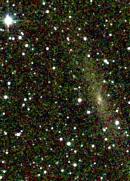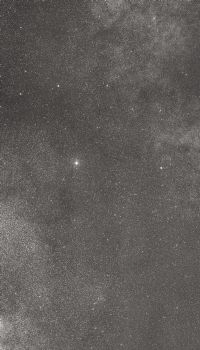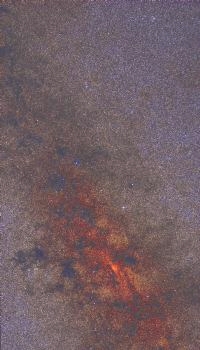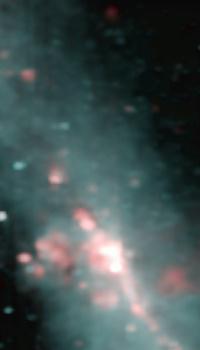The Impact of 2MASS
2MASS has already had a huge impact on astronomy, after only two years of
operations.

|
2MASS scientists have discovered the existence of very cool dwarf
stars and star-like objects, cooler than what was previously known. They have
dubbed these objects "L-type dwarfs". Recently, they have also confirmed
the existence of brown dwarfs, rich in atmospheric methane. These "T-type
dwarfs", as they have been called, barely contain more mass than Jupiter. A
nearby example is a companion, indicated at left by the arrow, to the
star Gleise 570. The faint T dwarf appears very blue in the near-infrared,
much
like the planets Uranus and Neptune do. An artist's rendition of the Gleise
570 system is at right. Both L dwarfs and T dwarfs are so low in mass
that they cannot produce internal energy as our Sun does, by thermonuclear
fusion. Instead, they shine, mostly in the infrared, by slowly collapsing
under their own weight. Together, L dwarfs and T dwarfs are twice as numerous
in the Milky Way Galaxy as full-fledged stars, like our Sun.
|

|
 2MASS scientists have also discovered new galaxies
in the plane of our Milky Way Galaxy. Away from the plane of our Galaxy,
other galaxies are seen pretty much uniformly distributed across the sky
(although, astronomers know that galaxies clump together in loose groupings
and clusters throughout the Universe).
In the so-called "Zone of Avoidance", astronomers optically see very few
galaxies, since the obscuring dust in the plane of our Milky Way hides
galaxies from view. But, in the near-infrared, many more galaxies are
detected in the plane. At left is a recent discovery of a spiral
galaxy, probably much like our own Milky Way, seen off in the distance, but
through the murky dust. The ability for 2MASS to penetrate through our
Galaxy's dust means astronomers can now more accurately count the number of
galaxies in our local Universe.
2MASS scientists have also discovered new galaxies
in the plane of our Milky Way Galaxy. Away from the plane of our Galaxy,
other galaxies are seen pretty much uniformly distributed across the sky
(although, astronomers know that galaxies clump together in loose groupings
and clusters throughout the Universe).
In the so-called "Zone of Avoidance", astronomers optically see very few
galaxies, since the obscuring dust in the plane of our Milky Way hides
galaxies from view. But, in the near-infrared, many more galaxies are
detected in the plane. At left is a recent discovery of a spiral
galaxy, probably much like our own Milky Way, seen off in the distance, but
through the murky dust. The ability for 2MASS to penetrate through our
Galaxy's dust means astronomers can now more accurately count the number of
galaxies in our local Universe.
In addition, for galaxies away from the Galactic plane that astronomers
already knew about, distances to a large number of these galaxies can now be
estimated, combining their 2MASS near-infrared brightnesses with radio
telescope observations of the way these galaxies rotate. From these distances,
out to about 3 billion light years, astronomers can better understand the
actual distribution of galaxies in the local Universe, which tells us a lot
of how galaxies formed and evolved since the Big Bang.
2MASS also offers an unprecedented view of the Milky Way, nearly free of the
obscuring effects of dust, revealing the true distribution of the luminous
mass in our Galaxy, and thus, the largest structures, over the entire extent
of the Galaxy. In other words, 2MASS will produce a map of our home Galaxy
at high resolution, never before accomplished at optical wavelengths.
Many more fascinating discoveries and insights await to be made by astronomers
all over the world, using the 2MASS catalogs and images, as the first large
offering of 2MASS data has hit the Internet. We anticipate that 2MASS will
have lasting and continuing value to astronomers, much as the Palomar optical
all-sky survey has, long after the survey is complete.
Finally, 2MASS lays the groundwork for future infrared NASA missions
that will peer into the sky at mid-infrared
and far-infrared wavelengths.
To demonstrate this, let's take a closer look at the center of our Galaxy.
Below are three panels, showing, at approximately the same scale and
location, the view of
the center at optical wavelengths
(left), the near-infrared 2MASS view (middle), and the view by
the IRAS satellite, the old prototype for the future mid- and far-infrared
missions (right).
| POSS
| 2MASS
| IRAS |

| 
|  |
Optical
| Near-Infrared
| Far-Infrared |
As you can see, the Galaxy's center is completely invisible at optical
wavelengths. But, 2MASS is revealing for the first time extraordinary details
about the center and its larger-scale environment. IRAS saw even more
structure, in the form of cool stars, nebulae, and dust, warmed by starlight,
albeit at pretty low resolution (see how fuzzy and blobby the structures
appear). Future airborne and space-based infrared missions, such as SOFIA,
SIRTF, and NGST will build upon what was learned almost twenty years ago by
IRAS, and use the unprecendented detail of the 2MASS near-infrared digital
image atlas to plan for and understand what these missions observe.
Altogether, the infrared astronomy of today, through 2MASS, and tomorrow,
will give us a much richer and complete understanding of our Universe.
Back to 2MASS: The All Sky Infrared Survey
Back to Main 2MASS Outreach Page
Return to the 2MASS Home
Page


 2MASS scientists have also discovered new galaxies
in the plane of our Milky Way Galaxy. Away from the plane of our Galaxy,
other galaxies are seen pretty much uniformly distributed across the sky
(although, astronomers know that galaxies clump together in loose groupings
and clusters throughout the Universe).
In the so-called "Zone of Avoidance", astronomers optically see very few
galaxies, since the obscuring dust in the plane of our Milky Way hides
galaxies from view. But, in the near-infrared, many more galaxies are
detected in the plane. At left is a recent discovery of a spiral
galaxy, probably much like our own Milky Way, seen off in the distance, but
through the murky dust. The ability for 2MASS to penetrate through our
Galaxy's dust means astronomers can now more accurately count the number of
galaxies in our local Universe.
2MASS scientists have also discovered new galaxies
in the plane of our Milky Way Galaxy. Away from the plane of our Galaxy,
other galaxies are seen pretty much uniformly distributed across the sky
(although, astronomers know that galaxies clump together in loose groupings
and clusters throughout the Universe).
In the so-called "Zone of Avoidance", astronomers optically see very few
galaxies, since the obscuring dust in the plane of our Milky Way hides
galaxies from view. But, in the near-infrared, many more galaxies are
detected in the plane. At left is a recent discovery of a spiral
galaxy, probably much like our own Milky Way, seen off in the distance, but
through the murky dust. The ability for 2MASS to penetrate through our
Galaxy's dust means astronomers can now more accurately count the number of
galaxies in our local Universe.


